Abstract
Interdisciplinary research (IDR) has become an important component in the conduction of leading-edge science and innovation. From the different approaches available to measuring IDR, bibliometric indicators have experienced the greatest growth. Despite the frequent use of bibliometric measures of IDR in research and policymaking, their adequacy has not been validated against scientists’ perceptions. Using the case of an IDR-oriented research institute in Japan, this study aims to investigate the differences and similarities between the outcomes of common bibliometric measures of IDR and the scientists’ perceptions of IDR. We used a unique dataset combining bibliometric measures with survey data collected from the scientists’ self-assessment of their research. This study also investigates the factors influencing the outcomes of bibliometrics and scientists' perceptions. Moreover, this study explores how IDR qualitative and quantitative measures differ from those that are more intuitive, such as scientific impact. It was observed that there is no “holy grail” measure for interdisciplinarity when compared with scientific impact, for which the impact factor is considered as a key metric by scientists. While bibliometric measures of interdisciplinarity show mild correlations with scientists' perceptions, they display high discriminatory power. The disagreement between qualitative and quantitative evaluations, as well as the significant field-specific nature of interdisciplinarity, calls for the use of multidimensional assessment approaches for assessing IDR, and the building of a consensus about the meaning and measurement of interdisciplinarity among scientists, respectively. The results of this study provide a series of guidelines for a more effective implementation of interdisciplinarity-oriented R&D policies at different organizational levels.




Similar content being viewed by others
References
Abramo, G., D’Angelo, C. A., & di Costa, F. (2017). Do interdisciplinary research teams deliver higher gains to science? Scientometrics, 111, 317–336.
Abramo, G., D’Angelo, C. A., & Zhang, L. (2018). A comparison of two approaches for measuring interdisciplinary research output: The disciplinary diversity of authors vs the disciplinary diversity of the reference list. Journal Informetrics, 12, 1182–1193.
Abramo, G., D’Angelo, C. A., & Costa, F. (2012). Identifying interdisciplinarity through the disciplinary classification of coauthors of scientific publications. Journal American Society Information Science Technology, 63, 2206–2222.
Adams, J., Loach, T., & Szomszor, M. (2016). Interdisciplinary research: Methodologies for identification and assessment. Digital Research Reports, Digital Science, London.
Amir-Aslani, A., & Mangematin, V. (2010). The future of drug discovery and development: Shifting emphasis towards personalized medicine. Technological Forecasting Social Change, 77, 203–217.
Anzai, T., Kusama, R., Kodama, H., & Sengoku, S. (2012). Holistic observation and monitoring of the impact of interdisciplinary academic research projects: An empirical assessment in Japan. Technovation, 32, 345–357.
Ávila-Robinson, A., & Miyazaki, K. (2013). Dynamics of scientific knowledge bases as proxies for discerning technological emergence—The case of MEMS/NEMS technologies. Technological Forecasting Social Change, 80, 1071–1084.
Avila-Robinson, A., & Sengoku, S. (2017). Multilevel exploration of the realities of interdisciplinary research centers for the management of knowledge integration. Technovation, 62, 22–41.
Callon, M., Courtial, J. P., Turner, W. A., & Bauin, S. (1983). From translations to problematic networks: An introduction to co-word analysis. Social Science Information, 22, 191–235.
Claudel, M., Massaro, E., Santi, P., Murray, F., & Ratti, C. (2017). An exploration of collaborative scientific production at MIT through spatial organization and institutional affiliation. PLoS ONE, 12, e0179334.
Dai, L., & Boos, M. (2017). How much sharing is enough? cognitive patterns in building interdisciplinary collaborations. In X. Fu, J. Luo, & M. Boos (Eds). Social Network Analysis: Interdisciplinary Approaches and Case Studies (pp. 41–70). NW: CRC Press.
Hessels, R. S., & Kingstone, A. (2019). Fake collaborations: Interdisciplinary science can undermine research integrity, June 29, 2019. https://doi.org/10.31234/osf.io/rqwea.
Huutoniemi, K., Klein, J. T., Bruun, H., & Hukkinen, J. (2010). Analyzing interdisciplinarity: Typology and indicators. Research Policy, 39, 79–88.
Jensen, P., & Lutkouskaya, K. (2014). The many dimensions of laboratories’ interdisciplinarity. Scientometrics, 98, 619–631.
Katoh, S., Lauto, G., Anzai, T., & Sengoku, S. (2018). Identification of factors to promote interdisciplinary research: A trial at COINS. In Proceedings of the 2018 Portland International Conference on Management of Engineering and Technology (PICMET), Honolulu, HI, USA, 19–23 August 2018, pp. 1–11.
Kessler, M. M. (1963). Bibliographic coupling between scientific papers. Journal Association Information Science Technology, 14, 10–25.
Klavans, R., & Boyack, K. W. (2017). Which type of citation analysis generates the most accurate taxonomy of scientific and technical knowledge? Journal Association Information Science Technology, 68, 984–998.
Kueffer, C., Underwood, E., Hadorn, G. H., Holderegger, R., Lehning, M., Pohl, C., Schirmer, M., Schwarzenbach, R., Stauffacher, M., & Wuelser, G. (2012). Enabling effective problem-oriented research for sustainable development. Ecology Society, 17(4), 8.
Larivière, V., & Gingras, Y. (2010). On the relationship between interdisciplinarity and scientific impact. Journal American Society Information Science Technology, 61, 126–131.
Lauto, G., & Sengoku, S. (2015). Perceived incentives to transdisciplinarity in a Japanese university research center. Futures, 65, 136–149.
Leinster, T., & Cobbold, C. A. (2012). Measuring diversity: the importance of species similarity. Ecology, 93, 477–489.
Levitt, J., & Thelwall, M. (2008). The most highly cited Library and Information Science articles: Interdisciplinarity, first authors and citation patterns. Scientometrics, 78, 45–67.
Leydesdorff, L. (2007). Betweenness centrality as an indicator of the interdisciplinarity of scientific journals. Journal American Society Information Science Technology, 58, 1303–1319.
Leydesdorff, L., & Rafols, I. (2011). Indicators of the interdisciplinarity of journals: Diversity, centrality, and citations. Journal Informetrics, 5, 87–100.
Leydesdorff, L., Wagner, C. S., & Bornmann, L. (2018). Betweenness and diversity in journal citation networks as measures of interdisciplinarity—A tribute to Eugene Garfield. Scientometrics, 114, 567–592.
Leydesdorff, L., Wagner, C. S., & Bornmann, L. (2019a). Diversity measurement: Steps towards the measurement of interdisciplinarity? Journal Informetrics, 13(3), 904–905.
Leydesdorff, L., Wagner, C. S., & Bornmann, L. (2019b). Interdisciplinarity as diversity in citation patterns among journals: Rao-Stirling diversity, relative variety, and the Gini coefficient. Journal Informetrics, 13, 255–269.
Littmann, M., Selig, K., Cohen-Lavi, L., Frank, Y., Hönigschmid, P., Kataka, E., & Rost, B. (2020). Validity of machine learning in biology and medicine increased through collaborations across fields of expertise. Nature Machine Intelligence, 2(1), 18–24.
Martín-Martín, A., Orduna-Malea, E., Thelwall, M., & López-Cózar, E. D. (2018). Google scholar, web of science, and scopus: A systematic comparison of citations in 252 subject categories. Journal Informetrics, 12, 1160–1177.
MIT (2016) Convergence: The future of health. Massachusetts Institute of Technology. Available online at: http://www.convergencerevolution.net/2016-report/ (accessed June 30, 2016).
Moed, H. F. (2006). Citation analysis in research evaluation. Springer.
Molas-Gallart, J., Rafols, I., & Tang, P. (2014). On the Relationship between Interdisciplinarity and Impact: Different modalities of interdisciplinarity lead to different types of impact. Journal Science Policy Research Management, 29, 69–89.
Morillo, F., Bordons, M., & Gómez, I. (2001). An approach to interdisciplinarity through bibliometric indicators. Scientometrics, 51, 203–222.
Mugabushaka, A.-M., Kyriakou, A., & Papazoglou, T. (2016). Bibliometric indicators of interdisciplinarity: The potential of the Leinster-Cobbold diversity indices to study disciplinary diversity. Scientometrics, 107, 593–607.
Porter, A. L., Cohen, A. S., Roessner, J. D., & Perreault, M. (2007). Measuring researcher interdisciplinarity. Scientometrics, 72, 117–147.
Porter, A., & Rafols, I. (2009). Is science becoming more interdisciplinary? Measuring and mapping six research fields over time. Scientometrics, 81, 719–745.
Porter, A. L., Roessner, D. J., & Heberger, A. E. (2008). How interdisciplinary is a given body of research? Research Evaluation, 17, 273–282.
Rafols, I. (2014). Knowledge Integration and Diffusion: Measures and Mapping of Diversity and Coherence. In Y. Ding, R. Rousseau, & D. Wolfram (Eds.), Measuring Scholarly Impact: Methods and Practice.Switzerland: Springer.
Rafols, I., Leydesdorff, L., O’Hare, A., Nightingale, P., & Stirling, A. (2012). How journal rankings can suppress interdisciplinary research: A comparison between innovation studies and business & management. Research Policy, 41, 1262–1282.
Rafols, I., & Meyer, M. (2010). Diversity and network coherence as indicators of interdisciplinarity: Case studies in bionanoscience. Scientometrics, 82, 263–287.
Rousseau, R. (2019). On the Leydesdorff-Wagner-Bornmann proposal for diversity measurement. Journal Informetrics, 13(3), 906.
Ruiz-Castillo, J., & Waltman, L. (2015). Field-normalized citation impact indicators using algorithmically constructed classification systems of science. Journal Informetrics, 9, 102–117.
Sanz MenéndezBordonsZulueta, L. M. M. (2001). Interdisciplinarity as a multidimensional concept: its measure in three different research areas. Research Evaluation, 10, 47–58.
Schmidt, J. C. (2008). Towards a philosophy of interdisciplinarity. Poiesis Praxis, 5, 53–69.
Schummer, J. (2004). Multidisciplinarity, interdisciplinarity, and patterns of research collaboration in nanoscience and nanotechnology. Scientometrics, 59, 425–465.
Siedlok, F., & Hibbert, P. (2014). The organization of interdisciplinary research: modes, drivers and barriers. International Journal Management Reviews, 16, 194–210.
Silva, F. N., Rodrigues, F. A., & Oliveira, O. N. (2013). Quantifying the interdisciplinarity of scientific journals and fields. Journal Informetrics, 7, 469–477.
Soós, S., & Kampis, G. (2011). Towards a typology of research performance diversity: the case of top Hungarian players. Scientometrics, 87, 357–371.
Stirling, A. (2007). A general framework for analysing diversity in science, technology and society. Journal Royal Society Interface, 4, 707–719.
van Eck, N. J., & Waltman, L. (2011). Text mining and visualization using VOSviewer. ISSI Newsletter, 7, 50–54.
Wagner, C. S., Roessner, J. D., Bobb, K., Klein, J. T., Boyack, K. W., Keyton, J., Rafols, I., & Börner, K. (2011). Approaches to understanding and measuring interdisciplinary scientific research (IDR): A review of the literature. Journal Informetrics, 5, 14–26.
Waltman, L., & van Eck, N. J. (2012). A new methodology for constructing a publication-level classification system of science. Journal American Society Information Science Technology, 63, 2378–2392.
Wang, J., Thijs, B., & Glänzel, W. (2015). Interdisciplinarity and impact: Distinct effects of variety, balance, and disparity. PLoS ONE, 10, e0127298.
Wang Q, Schneider JW (2019) Consistency and validity of interdisciplinarity measures. Quantitative Science Studies, 1, 239–263.
Whitesides, G. (2010). Solving problems. Lab on a Chip, 10, 2317–2318.
Yegros, A., D'este Cukierman, P., & Rafols, I. (2015). Does interdisciplinary research lead to higher citation impact? the different effect of proximal and distal interdisciplinarity. PLoS One, 10(8), e0135095. https://doi.org/10.1371/journal.pone.0135095.
Zhang, L., Rousseau, R., & Glänzel, W. (2016). Diversity of references as an indicator of the interdisciplinarity of journals: Taking similarity between subject fields into account. Journal Association for Information Science Technology, 67, 1257–1265.
Zhang, L., Sun, B., Chinchilla-Rodríguez, Z., Chen, L., & Huang, Y. (2018). Interdisciplinarity and collaboration: On the relationship between disciplinary diversity in departmental affiliations and reference lists. Scientometrics, 117, 271–291.
Author information
Authors and Affiliations
Corresponding author
Rights and permissions
About this article
Cite this article
Ávila-Robinson, A., Mejia, C. & Sengoku, S. Are bibliometric measures consistent with scientists’ perceptions? The case of interdisciplinarity in research. Scientometrics 126, 7477–7502 (2021). https://doi.org/10.1007/s11192-021-04048-0
Received:
Accepted:
Published:
Issue Date:
DOI: https://doi.org/10.1007/s11192-021-04048-0




